| [1]Mesires NT, Doumit ME,et al. Satellite cell proliferation and differentiation during postnatal growth of porcine skeletal muscle. Am J Physiol Cell Physiol. 2002;282(4):C899-906.
[2]Fujimaki S, Machida M, Hidaka R, et al. Intrinsic ability of adult stem cell in skeletal muscle: an effective and replenishable resource to the establishment of pluripotent stem cells.Stem Cells Int. 2013;2013:420164.
[3]Kao GW, Lamb EK, Kao RL. Skeletal muscle stem cells. Methods Mol Biol. 2013;1036:19-32.
[4]Ye L, Haider HKh, Tan R, et al. Angiomyogenesis using liposome based vascular endothelial growth factor-165 transfection with skeletal myoblast for cardiac repair. Biomaterials. 2008;29(13):2125-2137.
[5]王立新,高长青.自体骨骼肌星状细胞心肌成形的实验研究[J]. 中华医学杂志,2002,82(2):100-3.
[6]Lamb EK, Kao GW, Kao RL. Cellular cardiomyoplasty: its past, present, and future. Methods Mol Biol. 2013;1036:1-17.
[7]Tamaki T, Uchiyama Y, Okada Y, et al. Clonal differentiation of skeletal muscle-derived CD34(-)/45(-) stem cells into cardiomyocytes in vivo.Stem Cells Dev. 2010;19(4): 503-512.
[8]Xiang G, Yang Q, Wang B, et al. Lentivirus-mediated Wnt11 gene transfer enhances Cardiomyogenic differentiation of skeletal muscle-derived stem cells.Mol Ther. 2011;19(4): 790-796.
[9]Forte E, Chimenti I, Barile L, et al. Cardiac cell therapy: the next (re)generation. Stem Cell Rev. 2011;7(4):1018-1030.
[10]Kuliszewski MA, Kobulnik J, Lindner JR, et al. Vascular gene transfer of SDF-1 promotes endothelial progenitor cell engraftment and enhances angiogenesis in ischemic muscle. Mol Ther. 2011;19(5):895-902.
[11]Koning M, Werker PM, Schaft DW,et al. MicroRNA-1 and microRNA-206 improve differentiation potential of human satellite cells: a novel approach for tissue engineering of skeletal muscle. Tissue Eng Part A. 2012;18(9-10):889-898.
[12]Usas A, Huard J. Muscle-derived stem cells for tissue engineering and regenerative therapy. Biomaterials. 2007; 28(36):5401-5406.
[13]Ye L, Haider HKh, Tan R, et al. Angiomyogenesis using liposome based vascular endothelial growth factor-165 transfection with skeletal myoblast for cardiac repair. Biomaterials. 2008;29(13):2125-2137.
[14]徐青,徐敏,张加吉.壁虎骨骼肌卫星细胞的原代培养与鉴定[J].交通医学,2011,25(2):110-112.
[15]Mau M, Oksbjerg N, Rehfeldt C. Establishment and conditions for growth and differentiation of a myoblast cell line derived from the semimembranosus muscle of newborn piglets. In Vitro Cell Dev Biol Anim. 2008;44(1-2):1-5.
[16]Smith J, Merrick D. Embryonic skeletal muscle microexplant culture and isolation of skeletal muscle stem cells. Methods Mol Biol. 2010;633:29-56.
[17]Swedlow JR, Goldberg l, Brauner E, et al. Informatics and quantitative analysis in biological imaging. Science. 2003; 300(5616):100-102.
[18]KoningMM, GhoBC, VanKlaarwaterE, et al. Rapid ventricular pacing produces myocardial protection by nonischemic activation of KATP channels. Circulation. 1996;93 (1):178.
[19]Malatesta M, Giagnacovo M, Cardani R, et al. Human myoblasts from skeletal muscle biopsies: in vitro culture preparations for morphological and cytochemical analyses at light and electron microscopy. Methods Mol Biol. 2013;976: 67-79.
[20]Perruchot MH, Ecolan P, Sorensen IL, et al. In vitro characterization of proliferation and differentiation of pig satellite cells. Differentiation. 2012;84(4):322-329.
[21]陈静静,沈志森,巩长凤.骨骼肌卫星细胞的培养及其在骨骼肌组织工程研究中的应用[J].中国生物医学工程学报,2011,30(6): 955-960.
[22]杨成,周树夏,刘彦普,等. 肌肉组织工程的研究-高纯度卫星细胞培养方法[J].中国美容医学,2004,13(1):7-9.
[23]吕萍,马景涛.骨骼肌卫星细胞的分离和培养[J].河北医科大学学报,2006,27(4):305-307.
[24]Usas A, Huard J. Muscle-derived stem cells for tissue engineering and regenerative therapy. Biomaterials. 2007; 28(36):5401-5406.
[25]Qu Z, Balkir L, van Deutekom JC, et al. Development of approaches to improve cell survival in myoblast transfer therapy. J Cell Biol. 1998;142(5):1257-1267.
[26]夏家红,谢艾妮,徐磊,等. 大鼠骨骼肌卫星细胞体外培养的实验研究[J].中华实验外科杂志.2005;22(22):214-215.
[27]Ye L, Haider HKh, Tan R, et al. Angiomyogenesis using liposome based vascular endothelial growth factor-165 transfection with skeletal myoblast for cardiac repair. Biomaterials. 2008;29(13):2125-2137.
[28]Sato M, Ito A, Akiyama H, et al. Effects of B-cell lymphoma 2 gene transfer to myoblast cells on skeletal muscle tissue formation using magnetic force-based tissue engineering. Tissue Eng Part A. 2013;19(1-2):307-315.
[29]Sato M, Ito A, Kawabe Y, et al. Enhanced contractile force generation by artificial skeletal muscle tissues using IGF-I gene-engineered myoblast cells.J Biosci Bioeng. 2011;112(3): 273-278.
[30]姚茂金. 阳性脂质体在基因治疗中的前景[J]. 国外医学:遗传学分册,2003,26(5):251-253.
[31]陈彦祥,乔卫红,刘栋良,等. 阳离子脂质体的转染机制及转染效率影响因素[J]. 生物工程学报,2007,23(5):776-780. |
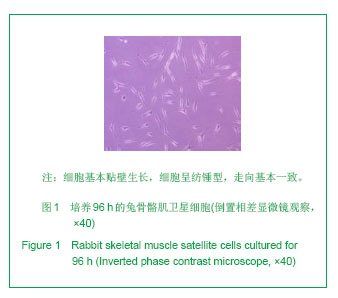
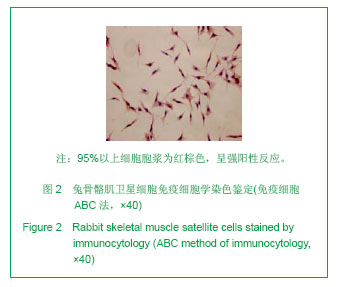
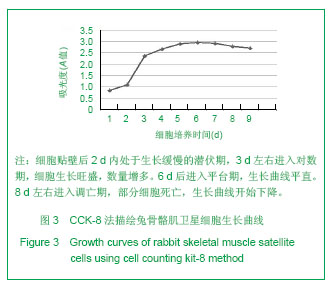
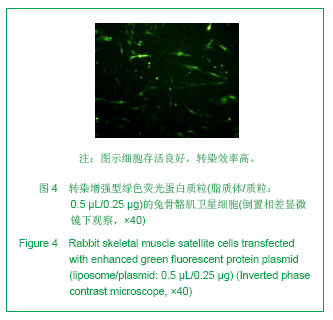
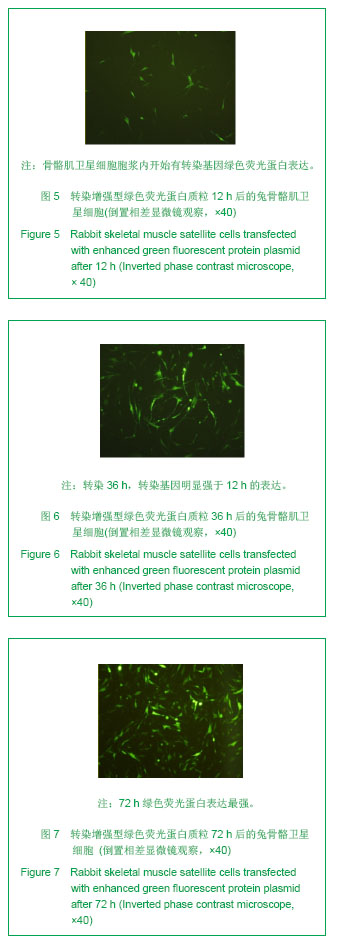
.jpg)
.jpg)